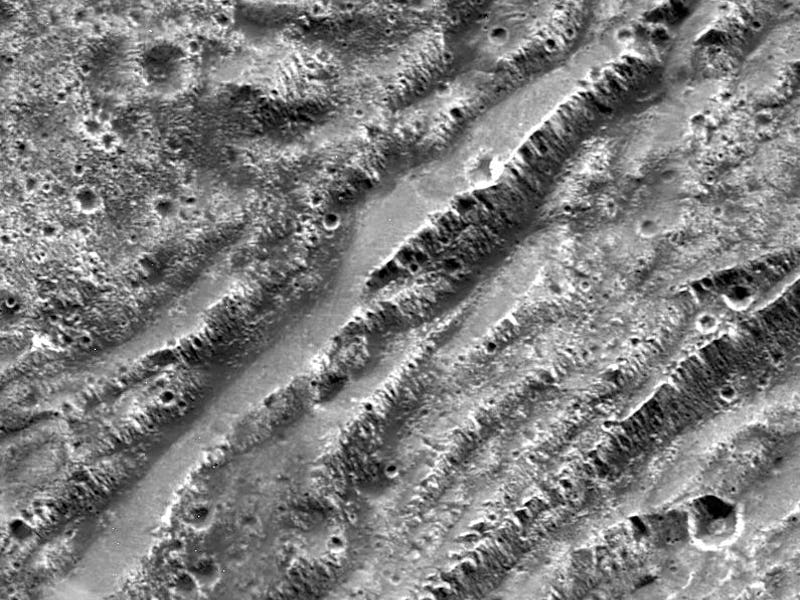Moonquakes? Scientists are cracking open the mystery of icy moons
Scientists are hunting for evidence of landslides on Europa and Ganymede.

The European Space Agency’s (ESA) recently launched Jupiter Icy Moons Explorer (JUICE) mission and NASA’s upcoming Europa Clipper mission could allow scientists to image landslides on the icy moons of Europa and Ganymede due to potential moonquakes on these small worlds.
This comes after a recent study examined fault scarps on Europa and Ganymede orbiting Jupiter and Enceladus and Dione orbiting Saturn to try to draw a connection between tectonic activity (quakes) and observed mass wasting (landslides) on these surfaces. The researchers “consider whether such smooth material can be generated by mass wasting triggered from local seismic shaking,” according to the study.
Moonquakes?
Active geological processes are not uncommon for moons orbiting Jupiter and Saturn. Their massive gravity induces tidal heating on these small bodies as the much larger planets stretch and compress the moons over millions of years, including the present day.
While flat, smooth terrains have been imaged extensively on the ocean worlds of Europa, Ganymede, and Enceladus, the longstanding hypothesis from scientists is this terrain is the result of fluid from icy volcanoes, also known as cryovolcanism, which has been observed on a number of planetary bodies throughout the solar system. However, given these moons are unspeakably cold and inhospitable for life, this hypothesis has been left unanswered until now.
NASA’s Galileo spacecraft snapped this close-up image of Europa’s surface in the 1990s displaying fault scarps, smooth slopes, and nearby rubble piles that could be indicative of landslides on the small moon. This image was cropped, rotated, and zoomed in from a much larger image.
For the study, the researchers measured steep ridges on the four moons hypothesized to be tectonic fault scarps. These scarps result from the surface splitting along a fault line and one side of the split dropping beneath the other. If this sounds familiar, these are very common on Earth.
The team then input these measurements into seismic models and determined an inferred magnitude range between 4.0 to 7.9 for Europa, Ganymede, and Enceladus. While scarps on Dione were measured, quakes and landslides on the moon were not modeled due to a lack of “structural models in Planetprofile and the seismogram database,” according to the study.
NASA’s Cassini spacecraft snapped this image of potential faults and scarps on Dione’s surface from ~500-km away on April 7, 2010.
“We found the surface shaking from moonquakes would be enough to cause surface material to rush downhill in landslides. We’ve estimated the size of moonquakes and how big the landslides could be,” said Mackenzie Mills, a Ph.D. student in the Lunar and Planetary Laboratory at the University of Arizona, and lead author of the study. Mills carried out the research throughout several summer internships at NASA’s Jet Propulsion Laboratory (JPL). “This helps us understand how landslides might be shaping moon surfaces over time.”
The researchers mention that data from the JUICE mission and the Europa Clipper mission “will advance both regional and local understanding of topography on these bodies,” meaning these spacecraft could both image and gather data on potentially active surface tectonics and mass wasting during their respective missions observing these moons.
ESA’s JUICE successfully launched on April 14 onboard an Ariane 5 rocket from Europe’s Spaceport in French Guinea and is currently estimated to arrive at Jupiter in 2031 after receiving a gravity assist from the Earth and Venus before sailing towards the solar system’s largest planet. The mission's goal is to investigate the habitability potential for three of Jupiter’s Galilean moons: Europa, Ganymede, and Callisto. While the first three years of the mission will consist of JUICE conducting elliptical orbits around Jupiter while it carries out 35 flybys of the three moons, in 2034, its mission is planned to change to only orbit Ganymede.
NASA’s Europa Clipper mission is currently scheduled to launch sometime in 2024 and is estimated to arrive at Jupiter in 2030. As its name implies, the Europa Clipper mission will try and determine the habitability potential for Jupiter’s second Galilean moon, Europa, as the spacecraft will conduct more than 50 close flybys of the ocean world with some flying as low as 25 kilometers (16 miles) of Europa’s icy surface. Due to Jupiter’s immense radiation, Europa Clipper will not be able to directly orbit Europa and instead carry out elliptical orbits around the gas giant to protect its instruments during the mission.
“We hope to gain a better understanding of the geological processes that have shaped icy moons over time and to what extent their surfaces may still be active today,” said Dr. Robert Pappalardo, who is a Europa Clipper project scientist at JPL, and a co-author on the recent study.
What new discoveries will scientists make about moonquakes in the coming years and decades? Only time will tell.
This article was originally published on Universe Today by Laurence Tognetti. Read the original article here.